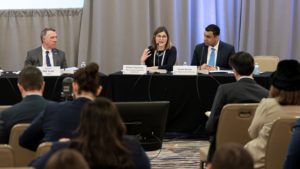
At the 2023 NGA Winter Meeting, Connecticut Governor Ned Lamont and Vermont Governor Phil Scott, Co-chairs of the Public Health and Disaster Response Task Force, hosted a discussion on how Governors can prepare their states and territories for potential largescale, sustained energy disruptions, through leveraging federal resources available to build resiliency, establish best practices and strengthen response efforts.
The discussion was part of NGA’s Public Health and Disaster Response Task Force, one of NGA’s three Governor-led task forces designed to foster a collaborative environment for Governors to focus on NGA’s top federal priorities for the 118th Congress now and in the future. The Public Health and Disaster Response Task Force has jurisdiction over areas including Federal Emergency Management Administration (FEMA), National Guard, cybersecurity, health care, immigration, human services, nutrition and COVID-19 issues related to testing, vaccines, supply chain and personal protective equipment. Learn more about the task force here.
The session featured conversations with: Jason Bordoff, Founding Director, Center for Global Energy Policy, Columbia University; Allison Clements, Commissioner, Federal Energy Regulatory Commission; and Puesh Kumar, Director, Office of Cybersecurity, U.S. Department of Energy.
Governor Lamont and Governor Scott kicked off the meeting by underscoring the importance of securing energy infrastructure, and the electrical grid in particular. They discussed the growing number of attacks on the electrical grid and the growing number of climate events, which are increasing in severity and frequency due to climate change. Governor Scott emphasized the importance of preparing for future events, stating “We’ve got to be forward looking and examine the current policy trends in order to build a more resilient energy landscape.”
Governor Scott then shared examples of work taking place in Vermont to build a more resilient energy landscape, including efforts to electrify the transportation sector by 2035 and the creation of Vermont’s Climate Council.
The panelists shared their expertise and insights about ways Governors, states and territories can work together and also utilize federal funding to build systems equipped to deal with current and future threats.
Director Puesh Kumar outlined the current risk landscape and the three areas that the Department of Energy is most focused on: cyber, physical, and climate-based risks. He highlighted funds made available to states through the Infrastructure Investment and Jobs Act (IIJA) and the Department of Energy’s commitment to working with states and territories to identify risks and build out risk profiles based on the unique needs of states and territories.

Specifically, on cyber risk, he highlighted recent legislation passed in New York to have cyber security requirements for critical infrastructure, like the electricity sector, and reiterated the Department’s commitment to partner with states and territories across the country who are considering similar legislation. He stated, “We’re going to be focused on state and territorial energy security plans with all the funding that’s attached to it, working with law enforcement, and ensuring cyber is synonymous with reliability and safety, as we think about the grid of the future.”
Commissioner Allison Clements remarked that many of the electrical grid systems in place now are outdated and not equipped to deal with the issues currently affecting states and territories. She emphasized the importance of states and territories working together at the regional level to plan ahead for real-life scenarios and to look forward to determine “what is our system going to need” and “what is the evolving physical and cyber threat going to require” in order to create models that identify risks across all scenarios and pinpoint strategic investments.

Mr. Jason Bordoff remarked that carbon emissions have been going up steadily every year, and when looking at solving climate security challenges globally, we need to do a better job of focusing on energy security. Similar to Commissioner Clements remarks on electrical grid systems not being equipped to deal with modern day risks, he stated that the system for global energy security is also ill equipped to handle the challenges we face today. He discussed the importance of federal funding like IIJA and IRA but noted that this type of funding is going to be needed consistently over time and must be dedicated to securing the energy sector. He also emphasized the need for more collaboration between the private and public sectors to secure critical infrastructure and encouraged governors to work with federal leaders to get a better understanding of the risks states and territories face.
Joining the conversation with Governors Lamont and Scott and the panelists, Governor Lou Leon Guerrero shared Guam’s cyber security concerns, given their proximity to Asia and having two military bases located in the territory, and their efforts to prepare for threats, including close coordination with federal partners.
In concluding remarks, Governor Lamont echoed a comment made by Director Kumar, noting that we need to always “prepare for a bad day, but planning will also help us to avoid that bad day and make sure we have a safe, carbon free future.” Governor Scott then thanked the panelists and closed out the session.












